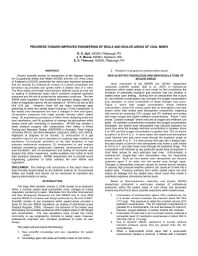Mining Publication: Progress Toward Improved Engineering of Seals and Sealed Areas of Coal Mines
Original creation date: February 2009
Authors: RK Zipf, JF Brune, ED Thimons
NIOSHTIC2 Number: 20035098
2009 SME Annual Meeting and Exhibit, February 22-25, Denver, Colorado, preprint 09-102. Littleton, CO: Society for Mining, Metallurgy, and Exploration, Inc., 2009; :1-11
Recent scientific studies by researchers at the National Institute for Occupational Safety and Health (NIOSH) and the U.S. Army Corps of Engineers (USACE) presented the worst-case explosion pressures that can develop if a methane-air mixture of a certain composition and dimension accumulates and ignites within a sealed area of a mine. The Mine Safety and Health Administration (MSHA) issued its final rule on sealing of abandoned areas which considers potential explosion pressures and the risk of achieving the necessary conditions. The new MSHA seals regulation has increased the pressure design criteria an order of magnitude beyond the old standard of 140 kPa (20 psi) to 800 kPa (120 psi). However, there still are major knowledge gaps pertaining to seals and sealed areas including: (1) the composition of the sealed area atmosphere and how it changes in time and space, (2) explosion pressures that might actually develop within sealed areas, (3) engineering procedures to follow when designing seals and seal installations, and (4) guidelines to manage the atmosphere within sealed areas with monitoring or inertization. NIOSH has initiated a seals research program with collaborators from Safety in Mines Testing and Research Station (SIMTARS) in Australia, West Virginia University (WVU), the Naval Research Laboratory (NRL), and USACE. Highlights of progress so far include: (1) construction of a gas explosion tube at Lake Lynn Laboratory for studying large methane-air explosions, (2) computer simulation of the fluid dynamics of high pressure methane-air explosions, (3) development of seal analysis methods considering construction materials, reinforcement and the seal foundation, and (4) development and testing of innovative seal designs that utilize inexpensive, readily-available rock rubble to resist high explosion pressures. NIOSH researchers aim to provide sound engineering guidelines to better address the new MSHA seal regulations.

NIOSHTIC2 Number: 20035098
2009 SME Annual Meeting and Exhibit, February 22-25, Denver, Colorado, preprint 09-102. Littleton, CO: Society for Mining, Metallurgy, and Exploration, Inc., 2009; :1-11
- Compendium of Structural Testing Data for 20-psi Coal Mine Seals
- Composition Change Model for Sealed Atmosphere in Coal Mines
- Explosion Pressure Design Criteria for New Seals in U.S. Coal Mines
- Explosion Pressure Design Criteria for Seals in U.S. Coal Mine - An Update on Work at NIOSH
- Historical Development of Technologies for Controlling Methane in Underground Coal Mines
- Reducing the Fire and Explosion Hazards of Flame-Cutting and Welding in Underground Coal Mines
- Rock Dusting Considerations in Underground Coal Mines
- Structural Analysis and Design of Seals for Coal Mine Safety
- Technology News 535 - NIOSH Releases New Educational Video: Escape from Farmington No. 9: An Oral History
- Use of Occupational Ethnography and Social Marketing Strategies to Develop a Safety Awareness Campaign for Coal Miners